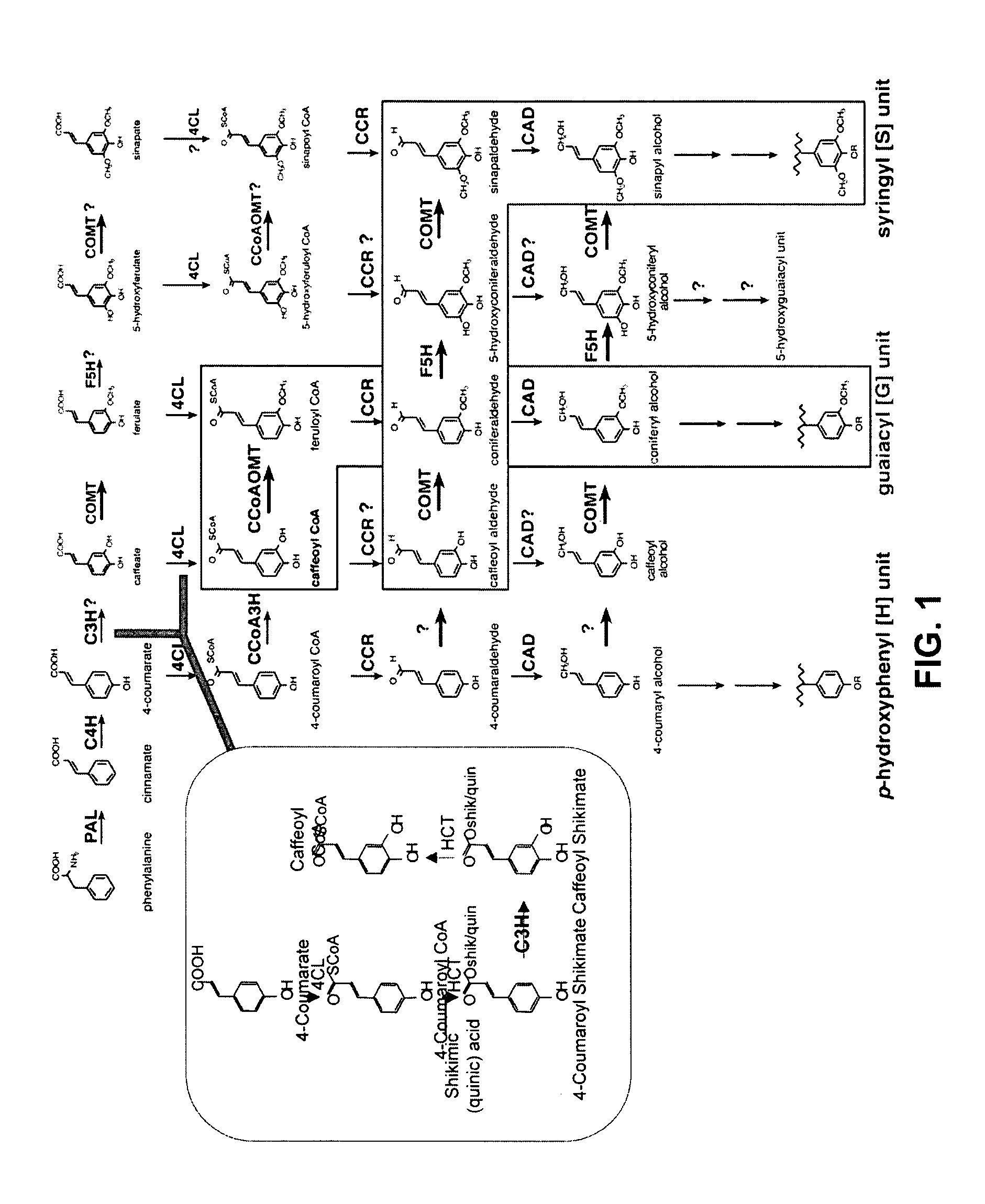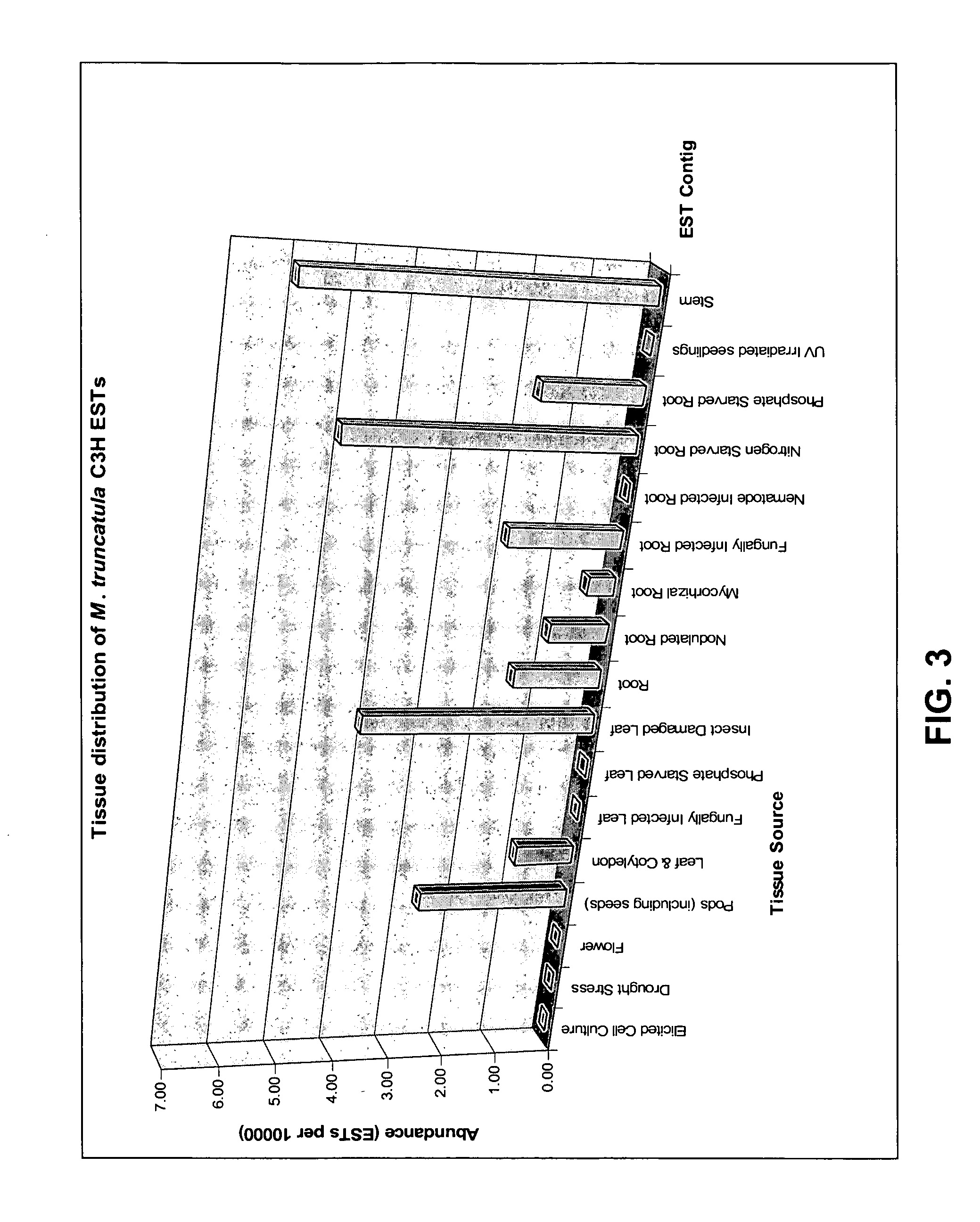Modification of lignin biosynthesis
- Summary
- Abstract
- Description
- Claims
- Application Information
AI Technical Summary
Benefits of technology
Problems solved by technology
Method used
Image
Examples
example 1
Creation of Transgenic Alfalfa Plants with Modified Lignin Composition
[0167] Antisense constructs were prepared using the base pCAMBIA2200-GW construct shown in FIG. 2. Constructs were prepared for down-regulation of each of the Medicago C3H, PAL, C4H, HCT and F5H coding sequences. The vector was modified by introducing a gene cassette with a pal2 promoter and Nos terminator followed by cloning of the gene of interest in antisense orientation by recombination using the Gateway™ technology.
[0168] The M. truncatula C3H, C4H and HCT sequences and Medicago PAL and F5H sequences were used. The antisense sequence corresponded to the coding portion of the cDNA. The constructs were each transformed into alfalfa (Medicago sativa) using the leaf-disk method and selected on kanamycin.
[0169] As an extensive collection of EST libraries of Medicago truncatula are available at the Noble Foundation, and since M. truncatula genes are very similar to alfalfa genes in their coding regions, it was c...
example 2
Phenolic Profiling of Transgenic Plants
[0184] Once the transgenic lines were screened for change in lignin composition, an analysis was carried out of phenolic profiles. FIG. 10 shows the soluble phenolic profiles of C3H and F5H downregulated lines compared to control. Even though there seemed to be several changes in the quality and size of the peaks, so far they have not been qualitatively identified.
[0185]FIG. 11 shows the profile of the wall bound phenolics of C3H and F5H downregulated lines compared to the control. As can be seen there is an increase in p-OH benzaldehyde and a decrease in vanillin in C3H downregulated line. There is little change in p-coumaric acid between the control and transgenic lines, but wall-bound ferulic acid levels are reduced in C3H transgenic lines. This may play an important role in increasing digestibility of forage grasses, where ferulate cross-linking of lignin to cell wall polysaccharides may inhibit digestibility. The F5H downregulated line ch...
example 3
Phenotypes of Lignin-Modified Alfalfa-
[0186] In addition to the dwarf phenotype noted above, additional phenotypes seen in some lines included change in flower color, delayed flowering; change in floral scent (in C4H down-regulated lines), and, in some lines such as a C3H line and a F5H line, increase in biomass at the flowering stage. In general, only those lines with the highest level of C3H down-regulation showed delayed growth. Thus, it is possible to produce alfalfa plants with strongly down-regulated C3H activity that develop normally but still show striking changes in lignification, a conclusion not apparent from the phenotype of the previously reported Arabidopsis ref8 mutant which lacks C3H activity and exhibits extreme dwarfism (Franke et al. 2002).
PUM
| Property | Measurement | Unit |
|---|---|---|
| Dimensionless property | aaaaa | aaaaa |
| Dimensionless property | aaaaa | aaaaa |
| Dimensionless property | aaaaa | aaaaa |
Abstract
Description
Claims
Application Information
 Login to View More
Login to View More - R&D
- Intellectual Property
- Life Sciences
- Materials
- Tech Scout
- Unparalleled Data Quality
- Higher Quality Content
- 60% Fewer Hallucinations
Browse by: Latest US Patents, China's latest patents, Technical Efficacy Thesaurus, Application Domain, Technology Topic, Popular Technical Reports.
© 2025 PatSnap. All rights reserved.Legal|Privacy policy|Modern Slavery Act Transparency Statement|Sitemap|About US| Contact US: help@patsnap.com



